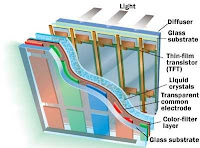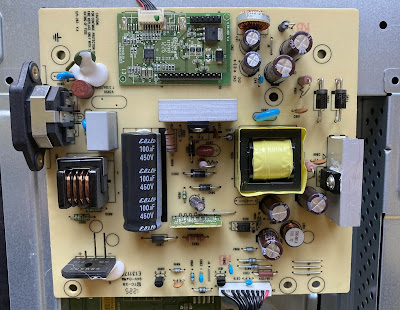Monitor One of the most important output
devices in computer system is its screen commonly called monitor. It is an
output device and displays all the programs and applications which are running
on the computer system. A Monitor is the visual display unit of the computer
system. It displays images generated from the video output. It displays images
without keeping a permanent record. A Graphic display is made up of a series of
dots called ‘pixels’ (picture elements) whose pattern produces images in
computer system. Each dot on the screen is defined as a separate unit which can
be addressed separately. Since each dot on the screen can be controlled
separately it gives greater flexibility in drawing pictures. The Number of dots
per inch (dpi) is called the resolution of the screen and represents the
quality of the computer system.
Cathode
Ray Tube Monitors (CRT)
Normal CRT monitor and
its internal working diagram In CRT monitors, the image is projected on the
screen by directing the electron beam onto the computer screen. To precisely
direct the electron beams, copper steering coils are used to create a magnetic
field inside the tube. By applying varying voltages to the copper coils a beam
can be positioned at any point on the screen.
Liquid
Crystal Displays (LCD)
First introduced in watches and clocks in the1970’s, LCDs are now used to display images in monitors. A newer technology in computer screens is TFT LCD monitors. These are light weight monitors and are used in laptop computers.
Active matrix structure is used by most of the modern LCD monitors and television sets.
In this technology, a matrix of thin-film transistors (TFT) is added to the polarizing and color filters. It enhances the display to make it look brighter and sharper. It can also produce much better images and have quicker response times.
These monitors are
portable, reliable and consume less electricity. Images produced by these
monitors are of better quality than that of old CRT monitors. The LCD monitors
have very high resolution and emit less radiation than CRT monitors. The screen
is also flicker free.
Thin Film Transistor Liquid Crystal Display (TFT LCD)
It is type of monitor
which used thin film transistor technology to enhance the image quality of LCD
Monitors. These are used as monitor in television set, desktop computer, laptop
computer and mobile phones etc.
Light
Emitting Diodes Monitors (LED)
Light Emitting Diodes (LED) is the latest technology which is being used now a days for making high definition TV screens and monitors. It is a semi-conductor light source. In this technology diodes are used to light up the screen instead of liquid crystal Diodes.
The Life of LED
monitors is three times than that of LCD monitors and they have less warm up
time than that of CRT or LCD monitors. These monitors require less space on the
desk, less power consumption and have flicker free screen.
Projection Displays
These are popularly used for seminars, class room lectures, marketing presentations and conference room presentations etc. 91 Input and Output Devices
Classification of monitors on the basis of color In terms of color capabilities, monitors can be divided into the following groups:
1. Monochrome :
These monitors display the result in two colors, i.e., black/white,
green/black, amber/black. One color is for the background of the screen and
other for the foreground.
2. Gray Scale:
It is a monochrome type of monitor. But it displays the output by using
different shades of gray, made by a combination of black and white.
3. Color Monitor:
It can display the output in many colors, ranging from 16 to over 1 million
different colors. These are also called as RGB monitors, because they accept
three separate signals, which are red, green, and blue.
Classification of
monitors on the basis of size
After color
classification, the most important aspect of a monitor is its screen size. The
Size of computer screen is measured in diagonal inches and is given by
measuring the distance from one corner to the opposite corner (diagonally). The
smallest size for VGA monitors is 14 inches, which is also the entry level
monitor for most computer systems. The Larger size landscape monitors can
display two full pages side by side at a time. Other typical monitor sizes are
17 inches, 20 inches, 23 inches etc.
Classification of
monitors on the basis of Resolution The resolution of a monitor means the
number of pixels per inch appearing on its surface. In general the greater the
number of pixels the sharper is the images. Most modern monitors can display
1024 by 768 pixels. Some high-end models of computer monitors can display 1280
by 1024, or even 1600 by 1200 pixels. Even 3280 by 2048 resolution monitors are
available for special purposes. While CRTs provide variability in resolution
LCDs monitor have a fixed resolution.
Classification of
monitors on the basis of signal
Computer monitor can be
divided into two categories on the basis of the type of signal which they accept.
These are:
1. Analog Monitor
2. Digital Monitor
Analog Monitor
The Electronic signal that is sent by signals of varying frequency, amplitude or phase instead of being sent as an ON or OFF data transmission is called an analog signal. Analog signals allow equipment to handle information that continuously changes such as voltage, current, etc. The greater the number of pixels the sharper is the images 92 Basics of Computer Hardware .
Analog signals can be represented by a wave sign and watches which changes their position continuously as shown in Figure
Figure 4.21: Examples of Analog Signal These are the traditional
type of color monitors and are based on CRT technology. These work like the
television screen and accept analog signals.
Digital Monitor:
An electronic signal that is sent as binary digits of either ON or OFF is called a Digital signal. As shown in Figure examples of digital signals and how they look like. In the first diagram signals are either 0 or 1 i.e. up or down for ON and OFF mode. In the right digital pictures are shown where a pixel is either ON or OFF helping to create an image on the display screen.
Figure Examples of
Digital Signal The digital monitor receives digital signals and can use CRT
technology. The data in these monitors is received from the video adapter.
These are of different types such as CGA (Color Graphics Adapter), EGA
(Enhanced Graphics Adapter), VGA (Video Graphics Array), and SVGA (Super Video
Graphics Array). These are fast and produce clear images.
.jpg)

.jpg)


.jpg)
.jpg)
.jpg)
.jpg)
.png)
.jpg)
Post a Comment
If you have any doubts, please let me know